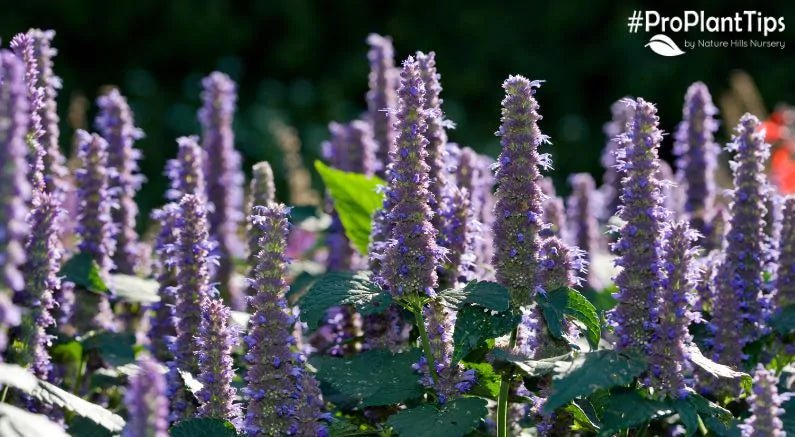Hyssop plants (Agastache) are perennial and evergreen plants that are must-haves if you want butterflies and hummingbirds to stop by your landscape for a visit! It's easy to see why this plant is also called Hummingbird Mint!

Agastache originates from the Greek word 'aga' meaning 'very much' and 'stachys' meaning 'spikes', referring to the many flower spikes Hyssops produce! Members of the highly aromatic and medicinal Mint Family, these square-stemmed flowering plants are gorgeous ornamentals with a world of uses beyond the garden!
Featuring colorful tubular blooms and scented foliage, the Hyssop has a long history! From flavorful and medicinal Teas to culinary flavoring, to a cleansing wash mentioned in the Bible, the beautiful Hyssop plant is a tall garden ornamental that will brighten your garden beds from spring until autumn!

The scalloped and quilted heart-shaped leaves are strongly scented and a cross between mint and licorice with a similar flavor. New growth can appear purple-blushed and form showy and tall flowering stems rising above mounds! Hyssop not only looks terrific, but it's also a mainstay for beneficial pollinators and our precious native bee populations. Attract beneficial insects galore, and send migrating Monarchs on their way south with a good nectar resource.
Anise Hyssop (Agastache) is a native Mint family plant with many cultivars and hybrids! It is not the same as the similarly named Hyssop (Hyssopus) which is a member of the Carrot family and native to Europe.
Learn about the many varieties you can find at Nature Hills!
Spicy, Aromatic & Beneficial!
Hyssops easily add color to your late-season garden, mixed-perennial borders, and Cottage gardens, because Hyssop is typically still blooming long after many other plants have finished! Pretty rosy lavender POQUITO™ Lavender Hyssop will fill your garden with its incredible flowering display!

Don't forget to snip a few for your indoor bouquets! Kudos™ Coral Hyssop and Blue Boa Anise Hyssop will add unique beauty to vase arrangements when combined with Bee Balm, Sea Holly, and vivid Coneflowers! The blooms shine in the sun and pair beautifully with various Lavenders, Sages, and Salvias!
Use fragrant Hyssop like the dramatically deep dark purple Purple Haze Hyssop or the pretty pink and orange Kudos™ Ambrosia and Kudos™ Gold Hyssop in the Cutting Garden and Sensory Garden to take advantage of their floriferous flowering and aromatic nature!
Can't pick one color to add to your garden? Have them all with the Tango Hyssop and dance to all the colors of the sunset in one!
No Butterfly Garden would be complete without a Hyssop and the POQUITO™ Orange or Kudos™ Yellow Hyssop! Bring in jeweled Hummingbirds that are attracted to the tubular flowers and bright colors, especially the red flowers of Sinning Sonoran Sunset or the vibrant Kudos™ Red Hyssop!
If you have a sunny flowering border, you'll want to use these in the mid-ground for a big boost of color. Partner these wand-like flowers with other herbs for height and backdrops that look great all season. Grow the plants in-ground, or use them as 'Thrillers' and 'Fillers' in large, mixed containers! Try a dwarf Hyssop like Little Adder Anise Hyssop in a sunny porch planter or as a gift. Or have fun pairing both the sunny Arizona Sun or pastel yellow, pink and orange Arizona Sunset Hyssops together for a cheerful color combo!
Tolerant of drier soil and xeric locations once established, Hyssop can be highly drought-tolerant! This makes them perfect for the Rock Garden or in a front yard berm, Hyssops can be grown along walkways and paths to scent your journey as you stroll. Adding an important fragrance element to your landscape! Kudos™ Silver Blue Hyssop or Kudos™ Mandarin Hyssop will light up those harsh sunnier areas!
Include Hyssop in the Kitchen garden and Herb garden, Hyssop leaves have been used dried and steeped to make a delicious, refreshing tea - either hot or iced! Add the colorful edible flowers either fresh or dried to flavor fruit salad, pasta, and salad.
Medicinally, Anise Hyssop tea or essential oil has purifying benefits, and its chemical compounds display antibacterial and antifungal properties plus Hyssop can be used as a cough reliever, and expectorant. Try growing Blue Fortune or native Anise Hyssop for your medicinal herb garden.
Easy to Grow Hyssop!
Handling a wide range of USDA hardiness zones from 5 - 10, the native form of Hyssop is hardy down to Zone 4! The aromatic foliage is deer and rabbit-resistant!

Give these easy-care Perennials a place in the sun with good air circulation. When you do water, add water to the root area keeping the foliage dry. Also, try to plant these garden gems where they can enjoy the drying powers of the morning sun to further help combat possible powdery mildew.
Plant in a well-drained soil location with regular moisture access for new plants. But once Hyssop has become established in your garden, it becomes a low water-usage plant and only needs supplemental watering during extended droughts. All plants appreciate a 3-4 inch deep layer of arborist mulch to regulate moisture loss and insulate the roots.
Deadhead often (or generously snip stems for bouquets!) to keep the blooms returning until frost. Because these plants can self-seed freely, deadheading also curbs their spread. Hyssop can also spread by underground rhizomes. In areas where this plant can be a nuisance, Nature Hills employs Plant Sentry™ to protect those ecosystems. Clean the mounds up and prune Hyssop back in the fall.
Heavenly Scented Hyssop!
Incredibly vivid blooms plus fragrance and long-lasting color - check out some Hyssop available on the NatureHills.com website!
Check out all the incredible Hyssops at Nature Hills for your pollinators, your kitchen, and your landscape! Enjoy the sight and smell of Hyssop and its many visitors to your garden today!
Happy Planting!


